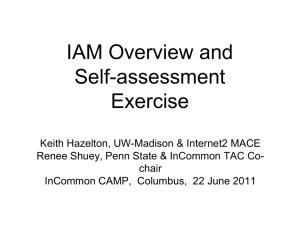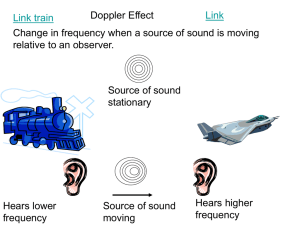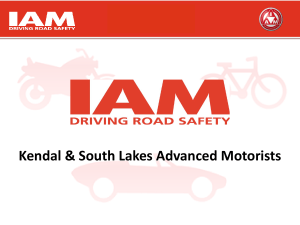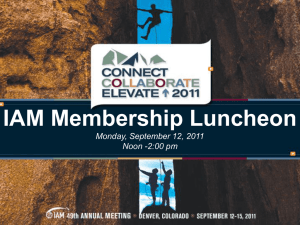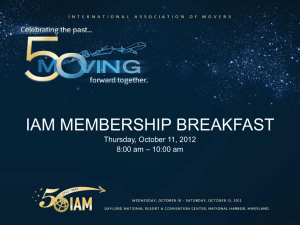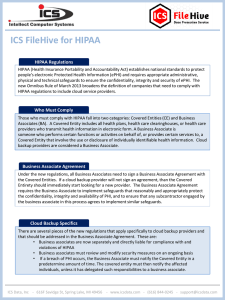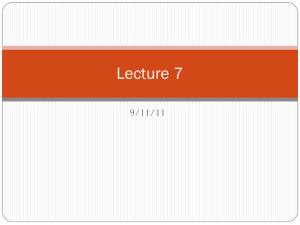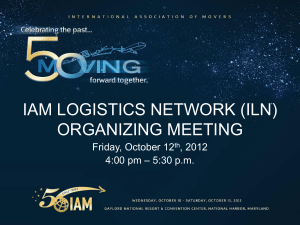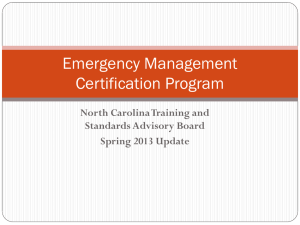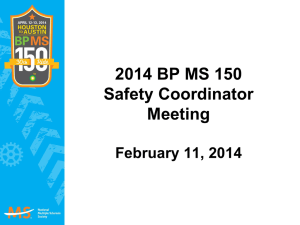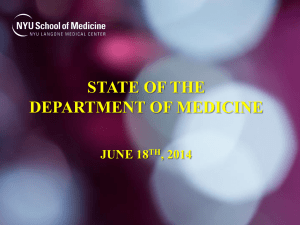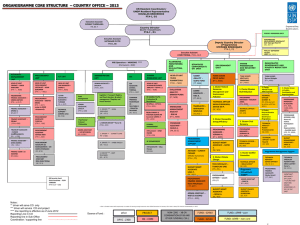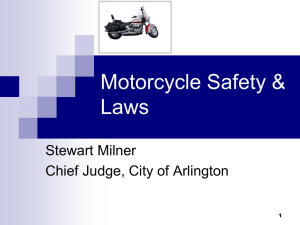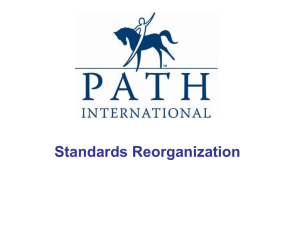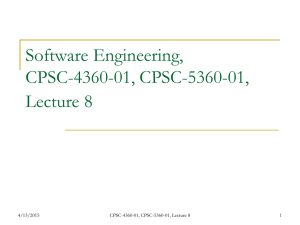Observation - Bristol Advanced Motorcyclists
advertisement
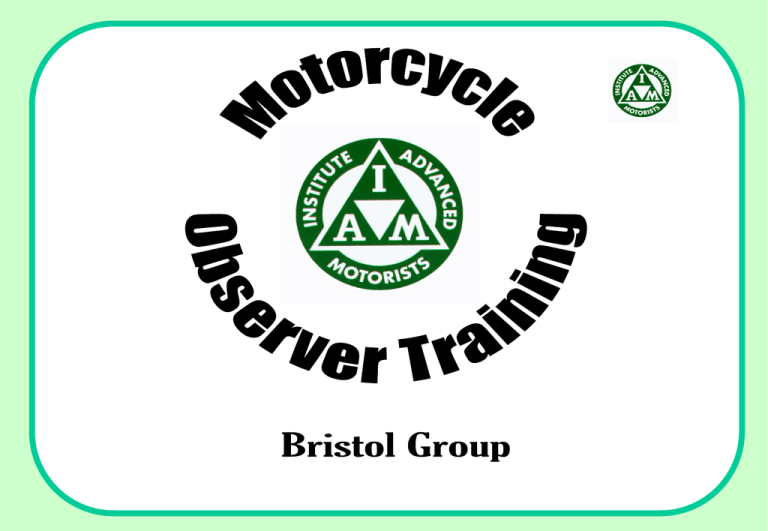
Welcome • I’m Billy Burns a Senior Observer and the BAM Chief Observer with the overall responsibility for the motorcycle coaching of BAM members, Associates and Observers. • In case of fire get out via the areas now being pointed out. • Toilets? • The following information is to provide you with an overview of IAM & BAM. The Contents • We will cover the following issues • Who or what is the IAM. • What is an IAM Observer • What being an Observer involves • Being an Observer within the Bristol Group All documents available on BAM Forum site under Observer Documentation • Motorcycle Observers Training Manual (MOTM) hard copy given at training evening • Letter to your insurance company • The IAM test. An IAM Examiners Point of view • BAM Observer report/assessment form. • IAM & BAM Organised Rides guide The IAM Who are they/we? • IAM house is based in London and has full time paid staff. (They are a road safety charity, as we are) • There are some 200 affiliated Groups including ourselves. We are independent bodies but we all share a common purpose and basic structure. • Groups are run entirely by unpaid volunteers ie all of us. The IAM Important terminology • The IAM do not want the words training and associate used together. • The term Observer implies a passive role and does not mean Instructor but the term coaching is acceptable. • The use of the term Observer Training, for example, is acceptable. • POST TEST TRAINING is likely to be the term used in the near future. IAM Skills For Life package • The ONLY way to become an IAM associate • Cost is presently £109 and includes: • Associate membership of IAM for 12 months from start of course & Group membership, see below • IAM book HTBAAM and Test fee (1st only) •After passing the IAM test, National membership for the remainder of the 12 months after starting course. (BAM membership until the following 31st December) Examiners • There are two types with qualifications divided between Car or Motorcycle. Some have both • Firstly, Staff examiners, they are employed by IAM London consisting of a Chief examiner plus regional examiners. There are presently 4 Motorcycle guys who conduct Senior Observer Tests. • Secondly there are local examiners who conduct our IAM test, Tony Oliver, Jim McCarter etc. They get paid a fee per test. Theory Books • There are two types. • IAM’s How To Become An Advanced Motorcyclist. (was called Pass your advanced motorcycle test.) • This is the book put forward to the DSA as the required standard for the standard IAM test. • It is presently being rewritten with publication sometime towards end of 2009 • Motorcycle Roadcraft This is thee book used for assessing ALL Observer standards. Higher level than HTBAAM and is the basis of all our training. It is the final authority on IPSGA matters as determined by relevant Motorcycle Staff Examiners. Observers • There are THREE levels of Observer. • Senior Observers • Qualified Observers • Trainee Observers. • Without Observers IAM could not exist. Information re Trainee Observer Training 12 Months Overview • An Induction classroom session at beginning of year • On the road session the followings Sunday. • Allocation to one of our 4 Group teams in time for the first Associate course of the year. • Mentored by a Senior Observer within that team • Allocation of two associates during the year. • Theory test and Qualified Observers practical test towards the end of their 12 months training. • Refer to your Motorcycle Observer Training Manual (MOTM) for more information Senior Observer IAM Training & Objectives • IAM have recently tightened up on the Senior Observer qualification. • They are strictly adhering to the high standard required by Senior Observers. They will use this as a means of cascading these standards down through the system to raise Observer standards and consequently Associate skill levels. • To this end they have restricted the test to be conducted only by 4 staff Motorcycle examiners, 2 in the North of the Country and 2 in the South. . • They have also introduced a Senior/Potential Senior Observer training day. The first was held by our Region in 2006 at the Police HQ in Portishead and has been rolled out across the Country. Senior Observers Cont • A Senior Observer has to requalify with a staff examiner every 6 years and within Group every 3 years. • Qualified Observer are required to requalify within the Group every 3 years. • We presently don’t have the resources to implement a QO retesting scheme but no doubt pressure will be forthcoming to do so. • IAM have a quality assurance scheme linked to the DSA which is working it’s way down the system! Why all this fuss about Senior Observers?? • One of the Staff examiners gave examples of candidates he examined to emphasise the variation of standards of SO throughout IAM • On the Test one guy completely left the road but fortunately regained enough control to get himself back on again!!! He had not even kept up to standard IAM test level. • One guy was asked how he tested the pressure in this tyres to which he promptly kicked both of them!! • Needless to say both went on to become examiners. • Only joking!! clearly they both failed. The 4 Team Areas • Team A covers West Bristol and North Somerset direction Leader Andy Williams with Ian Featherstone • Team B covers South Bristol & Somerset direction Leader Mike Holland • Team C covers East Bristol, parts of South Glos & Wiltshire direction. Leader Geoff Abraham with Rob Pepler • Team D covers North Bristol & parts of South Glos Leader Al Budden with Simon Whitelock • WE need to have structure but with flexibility. Allocation of Associates Responsibility of relevant Team Leaders Priorities • Numerical balance of Observers to Associates on each team depending on demand from specific areas. • Geographical considerations ie based in team area where they live, also applies to Observers. • We will do our best to accommodate, but the broader Group requirements & needs must receive priority. Qualified Observer • A Bristol Motorcycle IAM Observer needs to – communication, talk, demonstrate and suggest – motivate, encourage and stimulate – NOT about learning/improving your riding. – IT IS about how to put your knowledge across to associates • The best observers are – Committed to the cause. – Good communicators, enthusiastic people who are receptive to ideas. • Each Observer needs to keep in touch with their Team Leader and co-operate with spirit of the Group and it’s objectives. First contact with your Associate • Make contact with your allocated associate within a week of being notified of allocation. • Make an appointment with them soonest and get the ball rolling. • I suggest, from that point forward, make a weekly appointment or, if complicated, get associate to ring you on a Monday and sort a day out for that week. • The onus should then be on the associate to contact you. If you don’t hear from them for say two weeks then contact them. You should not have to continually chase them. How many rides? How long is a piece of string? • Average about 6 or 7 • Try to get your Associate up to test standard within a 10 week target. • When you think they are up to test standard arrange a Pre Test assessment/advice ride with a Senior Observer via your Team leader. • When the Associate has applied for their Test keep in touch and arrange a run a couple of days before the test. • Petrol contribution now £10 per ride MAX Ten rides. First ride out with Associate IDEALISM is not so memorable so can use:- PIDDLE Prepare a suitable route Introduce yourselves, explain route & purpose Document check Declaration (verbal) They are responsible for their own riding Look, bike roadworthy, suitable clothing Eyesight test (now part of the test) Purpose of First Observed Run • Make it an assessment ride • Look first for anything dangerous • Then look for a pattern of faults • Make an assessment of their riding standard – compared to HTBAAM/Roadcraft/your experience • Decide where you going to pitch your starting point? try to avoid teaching Grandma how to suck eggs? (give credit where credit is due) Riding Session tips • Start by keeping rides to about 20 minutes before stopping and reviewing. • Find roads that you can grade A,B,C etc to use according to rider’s present skill levels. • Increase riding distances as the Associate’s skill levels rises. Observing Safely • If you get separated tell associate they should stop at a safe place on the main road on the route. • Have a “if all else fails I’ll meet you there plan” the tea stop you were heading for is possibly the best option. • Follow at safe distance – assess ability before closing-up (having made sure their brake lights work???) •Have a stop signal (e.g. If I overtake you I am now in control. Please simply follow me) •Do not follow line a stern –offset, normally to the inside (example coming up) Preferred Observer Positioning Non-involvement? is vital and your responsibility First Ride (communicate) Recap • Don’t forget to PIDDLE • First ride is for you to assess Associate – put them at ease, ask him to ride as normal – tell them not to worry about the route • Look first for dangerous faults – stop and discuss any severe ones • Look for a pattern of faults First Debrief • Concentrate on the major issues first • Don’t give long list of faults – give them two or three things to practice before next observed ride. • Be positive, don’t intimidate – discuss strengths AND weaknesses • Follow-up with a demonstration ride • Arrange next appointment Debriefing • KISS Keep It Simple Stupid • Suggest & encourage • Remind the Associate of their responsibility for their own safety • Beware of verbal misunderstandings Some Observing Points • Observation – Scan horizon, use your peripheral vision to the full. Target potential or actual Hazards with CENTRAL vision then prioritise your RIDING PLAN – Regular mirror updates (every 7-10 seconds) again peripheral vision and clear blind spots BEFORE altering course or speed. • Positioning – FIRST Start with Central position then Nearside/Offside – Use road position to gain better view – ALWAYS sacrifice position for SAFETY • Hazard recognition – read the road – See early BUY “time to react” • IF you don’t LOOK for it you won’t SEE it but it IS THERE for• Bike control – Gears “correct one?” all to SEE if they LOOK. • IPSGA Get to grips with the system and Apply it – Brakes “USE them?” – Steering “countersteering?” – Throttle “acceleration sense” the art of smooth perfected riding Shoulder Checks Changing speed or road position? • Omitted by many new associates • Introduce early to Associate – gives time to get used to it – it should be smoothly integrated into the riding plan • Is their anything in the space you are about to move into? Is their anyone heading for it? • Practice by rote, always look, but apply with sense After the Basics • Road lines/position in bends • Good Safe Progress – encourage but not beyond ability • Overtakes – practice with you being overtaken • Slow speed control (techniques) • Motorways Common Faults • Poor Observations. View affords good forward and side observation but riders do not take advantage of them. • Too high a gear Forcing the bike to go straight on and wide to the outside of the bend, there is inadequate acceleration or deceleration using engine retardation when needed. Who’s in control, the bike or the ride?? • Positioning, especially Central position (Zone) • This zone is the safest area, as it gives clearance to pedestrians and other hazards. Alter your position depending on the hazards you encounter. Positioning & Signals The safest position to adopt when riding on the road should take into consideration actual or potential dangers. NEARSIDE risks from emerging vehicles, parked vehicles, cyclists & pedestrians. OFFSIDE risks from oncoming vehicles & traffic crossing from the offside. This zone is the safest area, as it gives clearance to pedestrians and other hazards. Alter your position depending on the hazards you encounter. The System of Motorcycle Control You need to maintain concentration when riding. Scan your environment for hazards. Comprehend the dangers and act on them. Keep looking around to ensure you take in all of your surroundings. I P S G A (1) • IPSGA is the Police system of Motorcycle control and is the foundation stone that all our efforts are built on. • It is a FLEXIBLE system where the rider makes the judgement calls and SAFETY is the HIGHEST priority. • A good understanding AND application of IPSGA is essential to progress your riding skills. I P S G A (2) • The point is not about whether you put your right foot, left foot or both feet down. (Who gives a s**t?) You can put a good argument for any or all of these. Present thinking is the right foot. Think higher! • The Point IS that a sound application of IPSGA gives you “Time to react”. Acquire and develop an noninvolvement policy regarding Road Traffic incidents! • No accident just happens, there is always a sequence of events. If you look for and recognise the symptoms you can avoid being the patient? I P S G A (3) • Are there points in Roadcraft that do not attract 100% agreement? • Yes there are, nothing is prefect. However, there no disagreements concerning the fundamental principles & applications.. • We need to concentrate on the big picture particularly the ability to LOOK for and SEE the signs that ARE there. ie Observation skills. The big I (eye) in IPSGA. • We ARE about saving motorcyclists lives and limbs by increasing their skill levels consummate with their vulnerability on a road in modern times. I P S G A (4) • You will get a feel for the riding skills level required to pass an IAM standard test. This is our minimum objective, more importantly we are about continuing to develop those skills for the rest of our riding life. • No system is perfect and no rider rides it perfectly. We are not about elitism • We are not trying to emulate the Police, we don’t have the time, resources or need to do that. We are trying to hand down the new skills we have recently acquired so that others may benefit. Sources of Help • MOTM Observer Training Manual • Motorcycle Road Craft (essential reading) • YOUR Team Senior Observer mentor (Your first port of call within the group) • Training Team Senior Observers • How To Be an Advanced Motorcyclist (IAM Book) • Group Ride experience, of which more in a minute. Internet access to Group Members Database • It’s main purposes are to help the Group maintain accurate details of members and improved internal communications. We have in excess of 200 paid up BAM Members plus 80 – 90 Associates a year. • Each Member and Associate has access to their personal details via a changeable password with the personal responsibility to keep it current. • It allows us to identify and place every Observer into their respective Teams to enhance better and easier communication and supervision by Team leaders. Group Members Database • There is a report a facility for ALL Observers and ALL Associates to log brief details of their respective rides. This is a simple data process recording Date, time, location, duration and rating. It is hoped that eventually this will incorporate full Ride reports. • As we grow we need better infrastructure to be more efficient and effective is our efforts, especially reducing the admin burden to those charged with running the Group. • Now that we are an independent Group we have numerous other requirements to meet including Subscription collection, Observer records and regular reports to IAM House etc etc. This database system is invaluable. Our Group rides • You are encouraged to join in on some of the Group rides. • They run on Sundays between March & October. • The first Sunday of the month is a morning run from 9am to 1pm • The third Sunday is an all day run starting at 10am to 4pm • These provide enjoyment and examples of IAM standards. • They are NOT assessed rides and should not be used as such!!! Ratio of Associates to Observer • The ratio of Associates to Observers should not exceed 2-1 whilst Advanced Riding guidance is being given on Observed runs. TEST results • Examiners NOW inform the Group of the an Associate’s Test result. (long story) • An Associate normally tell their Observer ie YOU. • It is your responsibility to please inform your Team Leader soonest. • Team Leader informs the Membership Secretary (Alan Davis). The Mem Sec welcomes the new IAM National member & BAM full member and sends them information about our latest activities.. • We don’t mind duplication of test result so please be sure the Group are aware. IAM Observer training morning Sunday 8th March 9.00 start Lincombe Barn • The plan is to divide up into groups of 1 Senior to two Trainee Observers.Follow the email instructions you received using the relevant advice in MOTM. I suggest a tea stop not more than an hour away to discuss and thaw out/warm up. Set off again back in the direction of Bristol to end up at Fowlers between 12.30 & 1pm. Folk can then disappear, have a cup of tea or lunch. • Please bring your copy of MOTORCYCLE OBSERVER TRAINING MANUAL in case it is needed. Remember Observing is about GOOD COMMUNICATIONS And finally ENJOY Observing is a very rewarding experience Associates Classroom evenings Due to the large number of Associates for this course (30), then add Trainee Observers and the presenters and Team leaders etc, there is insufficient space in the room for Observers. Due to the larger room we now have available to us the above no longer applies All new Trainee Observers are expected to attend the first three Associate evenings. In is also good practice to keep up with this evenings whilst you continue as an Observer. Feel free to contact your Team Senior Observers and your Team leaders The End
